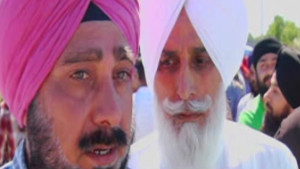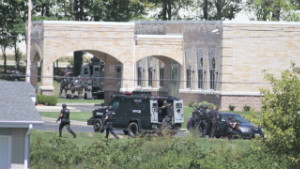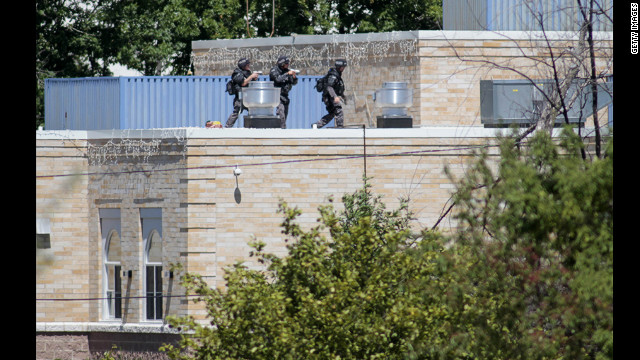Temple shooting dredges up memories of long history of bias crimes against Sikhs
August 6, 2012 -- Updated 1734 GMT (0134 HKT)
STORY HIGHLIGHTS
- Mistaken for Muslims because of their beards and turbans, Sikhs have become targets
- The first person murdered in retaliation for 9/11 was a Sikh
- The United States is home to about 700,000 Sikhs
- FBI doesn't specifically track bias crimes against the group
Mistaken for Muslims because of their beards and turbans, they became ripe targets for zealots seeking revenge.
The first person murdered
in retaliation for the 9/11 attacks was a Sikh -- a gas station owner
in Mesa, Arizona, named Balbir Singh Sodhi who was shot five times by
aircraft mechanic Frank Roque.
In the intervening years,
the Sikh Coalition, a New York-based advocacy group, reported more than
700 attacks or bias-related incidents.
 Temple member: 'State of disbelief'
Temple member: 'State of disbelief'
 Sikh community mourns victims
Sikh community mourns victims
 Witnesses: This is sad, devastating
Witnesses: This is sad, devastating
 Emergency calls in temple shooting
Emergency calls in temple shooting
Some Sikhs had their
houses vandalized; others were spat upon. In some extreme cases, Sikhs
were set upon by groups of people and beaten.
As the incidents waned,
the community had hoped the worst was behind them -- until Sunday, when a
man shot and killed at least six people at a Sikh temple outside
Milwaukee, wounded a police officer and was himself killed by another
officer's bullets.
Wade Michael Page, 40, an Army veteran, was the gunman and was killed by an officer at the scene, police said Monday.
Witnesses said the gunman had a 9/11 tattoo on one arm.
Police have received
information that the suspect "may have been involved in" the white
supremacist movement, but that has not been confirmed, Oak Creek Police
Chief John Edwards said.
While the shooter's
motives are not yet known, what is clear is that the incident has
dredged up the sense of shock and sadness Sikhs felt 11 years ago.
Rajwant Singh, from the
Maryland-Sikh Council on Religion and Education, said Sikhs growing up
in the United States should not feel as though they don't belong.
"Everybody should feel at home," he said Sunday. "This nation belongs to everyone."
But little seems to have changed.
The United States is
home to about 700,000 Sikhs, nearly all of Indian origin. The men are
easily identifiable by their beards and turbans, a tradition that's
lasted for 500 years.
But the attire and appearance have also meant that they are often mistaken for Muslims, and are targets of anti-Islam attacks.
"Our appearance looks
like Osama bin Laden and those of Afghanistan," Suminder Sodhi, a friend
of the Arizona victim, said at the time of the first attack. "But we
are different people from Muslim people. We have different beliefs, a
different religion."
Because many of the
incidents go unreported and because the FBI doesn't specifically list
them -- instead lumping them as "anti-Islamic" crimes -- exact numbers
are hard to come by.
Earlier this year, New York Rep. Joe Crowley sent a letter
to the Justice Department to begin tracking crimes against Sikhs. He
asked that the FBI update its Hate Crime Incident Report Form (1-699),
which does not have a designation for crimes against Sikhs as it does
for some other groups.
"The more information
our law enforcement agencies have on violence against Sikh-Americans,
the more they can do to help prevent these crimes and bring those who
commit them to justice," Crowley said.
Here are some instances from the long list of attacks that Sikhs have faced since 9/11:
-- September 15, 2001:
Roque guns down Sodhi outside a Mesa gas station. Roque drives up to
the station, fires five times and flees. He goes on to shoot at a
Lebanese-American gas station clerk and fire into the home of an
Afghan-American family later the same day. He is serving a life
sentence.
-- December 2001:
Two men beat store owner Surinder Singh 20 times with metal poles in
Los Angeles while they utter, "We'll kill bin Laden today."
-- March 2004:
Vandals scrawl the words, "It's not your country" in blue spray paint
on the wall of the Gurdwara Sahib temple in Fresno, California. The
temple was also vandalized a year earlier.
-- July 2004:
Rajinder Singh Khalsa is beaten unconscious by six men in New York
City, after they taunt him and his friend about their turban. The
beating leaves Khalsa with multiple fractures.
-- August 2006:
Iqbal Singh is stabbed in the neck with a steak knife in San Jose,
California, while he is standing in the carport of his house. The
attacker later tells police he wanted to "kill a Taliban."
-- October 2008:
Ajit Singh Chima is punched and kicked in the head while out on his
daily walk in Carteret, New Jersey. The attacker does not take anything
from Chima.
-- January 2009:
Jasmir Singh is attacked outside a New York grocery store, with men
shouting racial slurs. Two years later, his father is attacked.
-- November 2010:
Two passengers beat Harbhajan Singh, a Sikh cabdriver, in Sacramento,
California, with one of them calling him "Osama bin Laden."
-- March 2011:
Gurmej Singh Atwal and Surinder Singh are gunned down in Elk Grove,
California, while out on their afternoon walk. They are not robbed and
had no enemies, family members say.
-- February 2012:
A Sikh temple under construction in Sterling Heights, Michigan, is
defaced, with graffiti on the wall depicting a gun and a Christian
cross. Someone also scrawls "Mohmed," perhaps in reference to the Muslim
prophet Mohammed.
Sikhism, the world's
fifth most popular religion, is a monotheistic faith that believes in
equality and service to others, Sikh officials say.
CNN's Julie In contributed to this report.

 SWAT officers surround a Sikh
temple in Oak Creek, Wisconsin, where a gunman whom authorities
identified as Wade Michael Page, 40, stormed the building and opened
fire on Sunday, August 5. The incident left six people and the gunman
dead.
SWAT officers surround a Sikh
temple in Oak Creek, Wisconsin, where a gunman whom authorities
identified as Wade Michael Page, 40, stormed the building and opened
fire on Sunday, August 5. The incident left six people and the gunman
dead.
ไม่มีความคิดเห็น:
แสดงความคิดเห็น